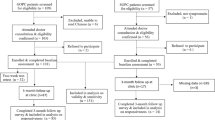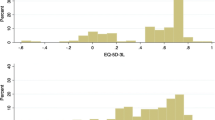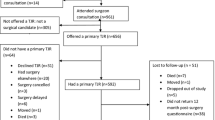Abstract
Purpose
To study the psychometric properties, including reliability, validity and responsiveness, of the Spanish EQ-5D-5L questionnaire for patients with hip or knee osteoarthritis (OA).
Methods
We included 758 patients with hip or knee OA who completed the EQ-5D-5L and Western Ontario and McMaster Universities Osteoarthritis Index (WOMAC) at baseline, of whom 644 also did 6 months later. The EQ-5D-5L contains five questions from which a utility index is derived. The WOMAC covers three dimensions: pain, stiffness and physical function. Floor and ceiling effects were calculated. Reliability was assessed using Cronbach’s alpha. Convergent validity was tested using the Spearman correlation coefficient between EQ-5D-5L and WOMAC. We examined known-groups validity by comparing the EQ-5D-5L between subgroups defined by WOMAC scores using ANOVA or the Kruskal–Wallis test. Effect sizes were calculated to assess responsiveness, and minimal clinically important difference (MCID) was estimated.
Results
The EQ-5D-5L showed minimal floor and ceiling effects (< 3%). Cronbach’s alpha was 0.86. The EQ-5D-5L index was strongly correlated with WOMAC pain and function scores (− 0.688 and − 0.782). Patients with higher WOMAC scores had significantly (p < 0.0001) lower EQ-5D-5L index. The 20.19% had hip or knee replacement during the follow-up. Effect sizes were small among non-surgical patients, but > 0.80 among “improved” surgical patients, being the MCID for improvement 0.32 points.
Conclusions
The results support the reliability, validity and responsiveness of the EQ-5D-5L, overcoming the limitations of the EQ-5D-3L in these patients. Therefore, the EQ-5D-5L could be very useful as an outcome measure, at least in patients with hip or knee OA.

Similar content being viewed by others
References
Mahon, J. L., Bourne, R. B., Rorabeck, C. H., Feeny, D. H., Stitt, L., & Webster-Bogaert, S. (2002). Health-related quality of life and mobility of patients awaiting elective total hip arthroplasty: A prospective study. CMAJ, 167, 1115–1121.
Núñez, M., Lozano, L., Núñez, E., Segur, J. M., Sastre, S., Macule, F., et al. (2009). Total knee replacement and health-related quality of life: Factors influencing long-term outcomes. Arthritis and Rheumatism, 61, 1062–1069.
Cushnaghan, J., Coggon, D., Reading, I., Croft, P., Byng, P., Cox, K., et al. (2007). Long-term outcome following total hip arthroplasty: A controlled longitudinal study. Arthritis and Rheumatism, 57, 1375–1380.
Rat, A. C., Guillemin, F., Osnowycz, G., Delagoutte, J. P., Cuny, C., Mainard, D., et al. (2010). Total hip or knee replacement for osteoarthritis: Mid- and long-term quality of life. Arthritis Care & Research, 62, 54–62.
Quintana, J. M., Escobar, A., Arostegui, I., Bilbao, A., Armendariz, P., Lafuente, I., et al. (2008). Prevalence of symptoms of knee or hip joints in older adults from the general population. Aging Clinical and Experimental Research, 20, 329–336.
Kaufman, S. (2001). The emerging role of health-related quality of life: Data in clinical research, part 2. Clinical Research, 1, 38–43.
Guyatt, G. H., Veldhuyzen van Zanten, S. J., Feeny, D. H., & Patrick, D. L. (1989). Measuring quality of life in clinical trials: A taxonomy and review. CMAJ, 140, 1441–1448.
Brazier, J., Ratcliffe, J., Salomon, J. A., & Tsuchiya, A. (2007). Measuring and valuing health benefits for economic evaluation. New York: Oxford University Press.
Brooks, R. (1996). EuroQol: The current state of play. Health Policy, 37, 53–72.
Dolan, P. (1997). Modeling valuations for EuroQol health states. Medical Care, 35, 1095–1108.
Drummond, M. F., Sculpher, M. J., Torrance, G. W., O’Brien, B. J., & Stoddart, G. L. (2005). Methods for the economic evaluation of health care programmes. New York: Oxford University Press.
EuroQoL Group. (1990). EuroQol—A new facility for the measurement of health-related quality of life. Health Policy, 16, 199–208.
Brazier, J., Roberts, J., Tsuchiya, A., & Busschbach, J. (2004). A comparison of the EQ-5D and SF-6D across seven patient groups. Health Economics, 13, 873–884.
Conner-Spady, B. L., Marshall, D. A., Bohm, E., Dunbar, M. J., Loucks, L., Al, K. A., et al. (2015). Reliability and validity of the EQ-5D-5L compared to the EQ-5D-3L in patients with osteoarthritis referred for hip and knee replacement. Quality of Life Research, 24, 1775–1784.
Janssen, M. F., Pickard, A. S., Golicki, D., Gudex, C., Niewada, M., Scalone, L., et al. (2013). Measurement properties of the EQ-5D-5L compared to the EQ-5D-3L across eight patient groups: A multi-country study. Quality of Life Research, 22, 1717–1727.
Johnson, J. A., & Pickard, A. S. (2000). Comparison of the EQ-5D and SF-12 health surveys in a general population survey in Alberta, Canada. Medical Care, 38, 115–121.
Sullivan, P. W., Lawrence, W. F., & Ghushchyan, V. (2005). A national catalog of preference-based scores for chronic conditions in the United States. Medical Care, 43, 736–749.
Fransen, M., & Edmonds, J. (1999). Reliability and validity of the EuroQol in patients with osteoarthritis of the knee. Rheumatology, 38, 807–813.
Ostendorf, M., van Stel, H. F., Buskens, E., Schrijvers, A. J., Marting, L. N., Verbout, A. J., et al. (2004). Patient-reported outcome in total hip replacement. A comparison of five instruments of health status. The Journal of Bone and Joint Surgery, 86, 801–808.
Herdman, M., Gudex, C., Lloyd, A., Janssen, M., Kind, P., Parkin, D., et al. (2011). Development and preliminary testing of the new five-level version of EQ-5D (EQ-5D-5L). Quality of Life ResearchQuality of Life Research, 20, 1727–1736.
Hinz, A., Kohlmann, T., Stobel-Richter, Y., Zenger, M., & Brahler, E. (2014). The quality of life questionnaire EQ-5D-5L: Psychometric properties and normative values for the general German population. Quality of Life Research, 23, 443–447.
Kim, T. H., Jo, M. W., Lee, S. I., Kim, S. H., & Chung, S. M. (2013). Psychometric properties of the EQ-5D-5L in the general population of South Korea. Quality of Life Research, 22, 2245–2253.
Yfantopoulos, J. N., & Chantzaras, A. E. (2016). Validation and comparison of the psychometric properties of the EQ-5D-3L and EQ-5D-5L instruments in Greece. Eur J Health Econ, 18, 519–531.
Buchholz, I., Thielker, K., Feng, Y. S., Kupatz, P., & Kohlmann, T. (2015). Measuring changes in health over time using the EQ-5D 3L and 5L: A head-to-head comparison of measurement properties and sensitivity to change in a German inpatient rehabilitation sample. Quality of Life Research, 24, 829–835.
Cheung, P. W., Wong, C. K., Samartzis, D., Luk, K. D., Lam, C. L., Cheung, K. M., et al. (2016). Psychometric validation of the EuroQoL 5-Dimension 5-Level (EQ-5D-5L) in Chinese patients with adolescent idiopathic scoliosis. Scoliosis and Spinal Disorders, 11, 19.
Garcia-Gordillo, M., Pozo-Cruz, D., Adsuar, B., Sanchez-Martinez, J. C., F. I., & bellan-Perpinan, J. M. (2014). Validation and comparison of 15-D and EQ-5D-5L instruments in a Spanish Parkinson’s disease population sample. Quality of Life Research, 23, 1315–1326.
Golicki, D., Niewada, M., Buczek, J., Karlinska, A., Kobayashi, A., Janssen, M. F., et al. (2015). Validity of EQ-5D-5L in stroke. Quality of Life Research, 24, 845–850.
Golicki, D., Niewada, M., Karlinska, A., Buczek, J., Kobayashi, A., Janssen, M. F., et al. (2015). Comparing responsiveness of the EQ-5D-5L, EQ-5D-3L and EQ VAS in stroke patients. Quality of Life Research, 24, 1555–1563.
Jia, Y. X., Cui, F. Q., Li, L., Zhang, D. L., Zhang, G. M., Wang, F. Z., et al. (2014). Comparison between the EQ-5D-5L and the EQ-5D-3L in patients with hepatitis B. Quality of Life Research, 23, 2355–2363.
Kim, S. H., Kim, H. J., Lee, S. I., & Jo, M. W. (2012). Comparing the psychometric properties of the EQ-5D-3L and EQ-5D-5L in cancer patients in Korea. Quality of Life Research, 21, 1065–1073.
Lee, C. F., Luo, N., Ng, R., Wong, N. S., Yap, Y. S., Lo, S. K., et al. (2013). Comparison of the measurement properties between a short and generic instrument, the 5-level EuroQoL Group’s 5-dimension (EQ-5D-5L) questionnaire, and a longer and disease-specific instrument, the Functional Assessment of Cancer Therapy-Breast (FACT-B), in Asian breast cancer patients. Quality of Life Research, 22, 1745–1751.
Lee, C. F., Ng, R., Luo, N., Wong, N. S., Yap, Y. S., Lo, S. K., et al. (2013). The English and Chinese versions of the five-level EuroQoL Group’s five-dimension questionnaire (EQ-5D) were valid and reliable and provided comparable scores in Asian breast cancer patients. Support Care Cancer, 21, 201–209.
Lin, F. J., Pickard, A. S., Krishnan, J. A., Joo, M. J., Au, D. H., Carson, S. S., et al. (2014). Measuring health-related quality of life in chronic obstructive pulmonary disease: Properties of the EQ-5D-5L and PROMIS-43 short form. BMC Medical Research Methodology, 14, 78.
Pattanaphesaj, J., & Thavorncharoensap, M. (2015). Measurement properties of the EQ-5D-5L compared to EQ-5D-3L in the Thai diabetes patients. Health and Quality of Life Outcomes, 13, 14.
Sakthong, P., Sonsa-Ardjit, N., Sukarnjanaset, P., & Munpan, W. (2015). Psychometric properties of the EQ-5D-5L in Thai patients with chronic diseases. Quality of Life Research, 24, 3015–3022.
Scalone, L., Ciampichini, R., Fagiuoli, S., Gardini, I., Fusco, F., Gaeta, L., et al. (2013). Comparing the performance of the standard EQ-5D 3L with the new version EQ-5D 5L in patients with chronic hepatic diseases. Quality of Life Research, 22, 1707–1716.
Tran, B. X., Ohinmaa, A., & Nguyen, L. T. (2012). Quality of life profile and psychometric properties of the EQ-5D-5L in HIV/AIDS patients. Health Qual Life Outcomes, 10, 132.
Yfantopoulos, J., Chantzaras, A., & Kontodimas, S. (2017). Assessment of the psychometric properties of the EQ-5D-3L and EQ-5D-5L instruments in psoriasis. Archives of Dermatological Research, 309, 357–370.
Conner-Spady, B. L., Marshall, D. A., Bohm, E., Dunbar, M. J., & Noseworthy, T. W. (2018). Comparing the validity and responsiveness of the EQ-5D-5L to the Oxford hip and knee scores and SF-12 in osteoarthritis patients 1 year following total joint replacement. Quality of Life Research, 27(5), 1311–1322
Ramos-Goñi, J. M., Craig, B. M., Oppe, M., Ramallo-Fariña, Y., Pinto-Prades, J. L., Luo, N., et al. (2017). Handling data quality issues to estimate the Spanish EQ-5D-5L value set using a hybrid interval regression approach. Value Health, 21(5), 596–604
Guyatt, G. H., Osoba, D., Wu, A. W., Wyrwich, K. W., Norman, G. R., & Clinical Significance Consensus Meeting Group. (2002). Methods to explain the clinical significance of health status measures. Mayo Clinic Proceedings, 77, 371–383.
Bellamy, N., Buchanan, W. W., Goldsmith, C. H., Campbell, J., & Stitt, L. W. (1988). Validation study of WOMAC: A health status instrument for measuring clinically important patient relevant outcomes to antirheumatic drug therapy in patients with osteoarthritis of the hip or knee. Clinical Rheumatology, 15, 1833–1840.
Escobar, A., Quintana, J. M., Bilbao, A., Azkarate, J., & Guenaga, J. I. (2002). Validation of the Spanish version of the WOMAC questionnaire for patients with hip or knee osteoarthritis. Western Ontario and McMaster Universities Osteoarthritis Index. Clinical Rheumatology, 21, 466–471.
Escobar, A., Quintana, J. M., Bilbao, A., Arostegui, I., Lafuente, I., & Vidaurreta, I. (2007). Responsiveness and clinically important differences for the WOMAC and SF-36 after total knee replacement. Osteoarthritis Cartilage, 15, 273–280.
Quintana, J. M., Escobar, A., Bilbao, A., Arostegui, I., Lafuente, I., & Vidaurreta, I. (2005). Responsiveness and clinically important differences for the WOMAC and SF-36 after hip joint replacement. Osteoarthritis Cartilage, 13, 1076–1083.
Wyrwich, K. W., Tierney, W. M., & Wolinsky, F. D. (1999). Further evidence supporting an SEM-based criterion for identifying meaningful intra-individual changes in health-related quality of life. Journal of Clinical Epidemiology, 52, 861–873.
Cronbach, L. J. (1951). Coefficient alpha and the internal structure of test. Psychometrika, 16, 297–334.
Nunnally, J. C., & Bernstein, I. H. (1994). Psychometric theory (3rd ed.). New York: McGraw-Hill.
Cohen, J. (1988). Statistical power analysis for the behavioural sciences. New York: Academic Press.
Guillemin, F., Bombardier, C., & Beaton, D. (1993). Cross-cultural adaptation of health-related quality of life measures: Literature review and proposed guidelines. Journal of Clinical Epidemiology, 46, 1417–1432.
Cohen, J. (1992). A power primer. Psychological Bulletin, 112, 155–159.
Hays, R. D., & Woolley, J. M. (2000). The concept of clinically meaningful difference in health-related quality-of-life research. How meaningful is it? Pharmacoeconomics, 18, 419–423.
Schmitt, J. S., & Di Fabio, R. P. (2004). Reliable change and minimum important difference (MID) proportions facilitated group responsiveness comparisons using individual threshold criteria. Journal of Clinical Epidemiology, 57, 1008–1018.
Wyrwich, K. W., Tierney, W. M., & Wolinsky, F. D. (2002). Using the standard error of measurement to identify important changes on the Asthma Quality of Life Questionnaire. Quality of Life Research, 11, 1–7.
de Boer, M. R., de Vet, H. C., Terwee, C. B., Moll, A. C., Volker-Dieben, H. J., & van Rens, G. H. (2005). Changes to the subscales of two vision-related quality of life questionnaires are proposed. Journal of Clinical Epidemiology, 58, 1260–1268.
Brazier, J. E., Harper, R., Munro, J., Walters, S. J., & Snaith, M. L. (1999). Generic and condition-specific outcome measures for people with osteoarthritis of the knee. Rheumatology, 38, 870–877.
Walters, S. J., & Brazier, J. E. (2005). Comparison of the minimally important difference for two health state utility measures: EQ-5D and SF-6D. Quality of Life Research, 14, 1523–1532.
Terwee, C. B., Dekker, F. W., Mourits, M. P., Gerding, M. N., Baldeschi, L., Kalmann, R., et al. (2001). Interpretation and validity of changes in scores on the Graves’ ophthalmopathy quality of life questionnaire (GO-QOL) after different treatments. Clinical Endocrinology (Oxford), 54, 391–398.
Acknowledgements
We are grateful to colleagues in the participating hospitals and primary care centres for their support and to all patients for their collaboration. We acknowledge the help provided by the Biostatistics Research Group (Biostit), supported by the Department of Education, Linguistics Policy and Culture of the Basque Government (Ref: IT620-13). We also acknowledge the editorial assistance provided by Ideas Need Communicating Language Services, through the translation and edition service of the Basque Foundation for Health Innovation and Research (BIOEF).
Funding
This study was supported in part by grants from the Carlos III Health Institute (PI13/00560, PI13/00518 and PI13/00648) and the European Regional Development Fund.
Author information
Authors and Affiliations
Corresponding author
Ethics declarations
Conflict of interest
The authors declare that they have no conflict of interest.
Ethical approval
All procedures performed in studies involving human participants were in accordance with the ethical standards of the institutional and/or national research committee and with the 1964 Helsinki Declaration and its later amendments or comparable ethical standards. This study received the approval of the following Ethics Committees for Clinical Research: ECCR of Euskadi (PI2014050), Hospital Fundación Jiménez Díaz (PIC 80/2013_HRJC), Hospital Universitario de Fuenlabrada (APR 14–27), Hospital Universitario Fundación Alcorcón (14/19), Hospital Universitario de Canarias (2014–109) and Hospital Universitario Nuestra Señora de Candelaria (PI-09/15).
Informed consent
Informed consent was obtained from all individual participants included in the study.
Rights and permissions
About this article
Cite this article
Bilbao, A., García-Pérez, L., Arenaza, J.C. et al. Psychometric properties of the EQ-5D-5L in patients with hip or knee osteoarthritis: reliability, validity and responsiveness. Qual Life Res 27, 2897–2908 (2018). https://doi.org/10.1007/s11136-018-1929-x
Accepted:
Published:
Issue Date:
DOI: https://doi.org/10.1007/s11136-018-1929-x




